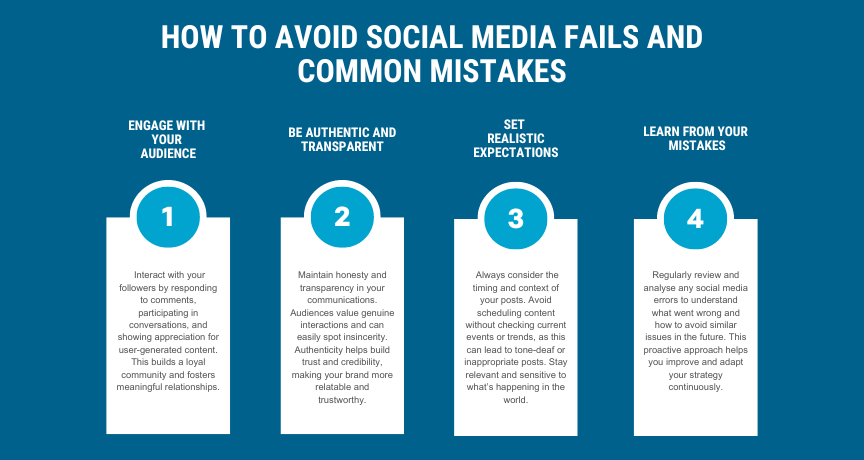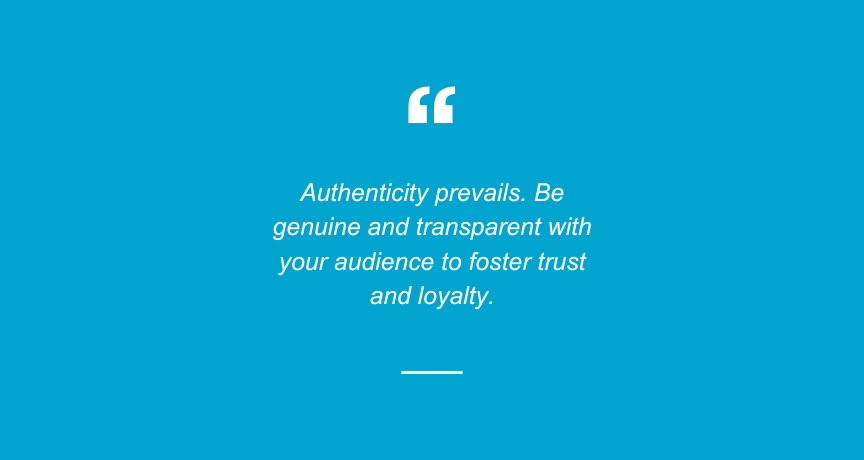Over the last decade, social media has become almost ingrained in our day-to-day lives.
With over 4.9 billion social media users globally, brands are increasingly using social media platforms to engage with their audiences, promote their products, and enhance their reputation.
However, as we’ve seen in numerous high-profile cases, navigating the complexities of social media can be a double-edged sword. Social media can create remarkable opportunities for connection and engagement, but it can also lead to significant pitfalls when brands miss the mark.
A notable example of social media’s potential for both success and disaster is the infamous Colin vs. Cuthbert legal battle in 2021, which Aldi navigated with clever social media engagement.
This incident raises a critical question: how can businesses ensure their content is effective and avoid social media fails?
This article will go over social media marketing, give some common pitfalls to avoid, and provide some inspiring case studies of successful strategies to get you started on your own social media campaign.
The Rise of Social Media
Platforms like Facebook, Twitter, Instagram, TikTok, and LinkedIn have become essential for reaching target audiences and driving engagement.
Recent research indicates that more than half of customers follow companies on social media, underscoring the platform’s significance as a means of communicating with brands.
Traditional corporate accounts often create unengaging content, which leads to a lack of interaction from audiences, contrasting this with more provocative or humorous approaches like that of RadioShack's Twitter presence.
This rise in social media usage has shifted how businesses communicate with their audiences.
Businesses can now share content in real-time, respond to customer inquiries instantly, and cultivate a loyal following.
However, this immediacy also means that businesses must be vigilant; a single misstep can lead to a social media disaster that can significantly damage a brand’s reputation.
Consumer Expectations
As social media has evolved, so have consumer expectations. Twitter users, in particular, play a significant role in shaping brand perception through their reactions and interactions.
Today’s social media users demand transparency, authenticity, and engagement from the brands they follow.
They expect quick responses to queries and concerns, with 69% of users anticipating a response within 24 hours. This shift means businesses must actively monitor their social media channels and foster genuine relationships with their audience.
Additionally, consumers increasingly look for brands that take a stand on social issues and align with their values.
To succeed in this environment, brands must strike a careful balance, though, since customers value socially conscious companies but may also be suspicious of those that come across as shady or self-serving.

Common Social Media Mistakes to Avoid
Mistake #1: Ignoring Audience Awareness
One of the most significant mistakes businesses can make on social media is failing to understand their audience.
When brands overlook their target demographic’s values, interests, and preferences, they risk creating content that doesn’t resonate.
Example: Burger King’s infamous International Women’s Day campaign in 2021 is a prime example of this mistake. Their tagline, “Women belong in the kitchen,” aimed to spark conversations about gender equality in the culinary world. However, many consumers thought that this messaging was tone-deaf and misogynistic. The backlash was swift, with critics arguing that the campaign alienated the very audience it intended to engage.
Lesson: This incident illustrates the importance of knowing your audience. Brands must align their messaging with the values and sentiments of their target audience to avoid alienation and backlash.
Mistake #2: Failing to Monitor Current Events
In today’s fast-paced world, staying aware of current events is crucial for brands engaging on social media. Posting content that is disconnected from ongoing discussions or news can lead to serious missteps.
Example: During the 2013 horse meat scandal, Tesco tweeted “It’s sleepy time, so we’re off to hit the hay!” just as the news broke. This poorly timed post was not only inappropriate but also highlighted the company’s lack of awareness about the situation, leading to public outrage and further damaging their reputation.
Lesson: Businesses must regularly monitor news and trends relevant to their audience to ensure that their content is timely and sensitive to current events. A pulse on what’s happening in the world can help brands avoid tone-deaf posts that may lead to social media disasters.

Mistake #3: Poor Crisis Management
Even well-established brands can find themselves embroiled in controversy, sometimes resulting in a social media PR disaster.
How they handle these situations often determines the impact on their brand image. A lack of effective crisis management can exacerbate the situation and lead to long-term reputational damage.
Example: Dove’s Transformation Campaign faced significant backlash when it featured a black woman transforming into a white woman, which was perceived as racially insensitive and contradictory to the brand’s message of inclusivity. The negative reaction not only overshadowed the intended message but also called into question Dove’s commitment to diversity and inclusivity.
Lesson: Companies must have a solid crisis communication plan in place to respond effectively to backlash. A timely acknowledgment of the mistake, a sincere apology, and a commitment to do better can help mitigate damage and rebuild trust with consumers.
Positive Examples of Social Media Campaigns in the UK
Many businesses in the UK have taken advantage of social media’s ability to foster close bonds with customers and increase brand loyalty.
A skilled social media manager plays a crucial role in these efforts, ensuring that campaigns are both creative and engaging.
These companies have established the benchmark for successful social media marketing, with their creative campaigns and genuine interaction.
Let’s examine a few noteworthy instances of how they have effectively used social media to their benefit.
Example #1: BrewDog’s Social Responsibility Initiatives
BrewDog, the Scottish craft beer company, has effectively used social media to promote its brand values and engage with its audience through transparency and social responsibility.
Description: BrewDog frequently shares updates about their sustainability efforts, charitable initiatives, and community involvement on social media. For instance, during the pandemic, they pivoted their operations to produce hand sanitizer and shared their journey with followers, showcasing their commitment to social good.
Takeaway: By aligning their brand with meaningful causes and being transparent about their efforts, BrewDog has fostered a loyal community of supporters. This approach highlights the importance of authenticity and social responsibility in modern marketing.
Example #2: Gymshark’s Influencer Marketing
Gymshark, a UK-based fitness apparel brand, has mastered the art of influencer marketing on social media. The brand has successfully built a community of fitness enthusiasts and advocates through partnerships with influencers.
Description: Gymshark collaborates with fitness influencers and athletes to showcase their products and promote an active lifestyle. Their social media strategy includes user-generated content and fitness challenges that encourage engagement from their audience.
Takeaway: By leveraging the power of influencers and fostering a sense of community, Gymshark has created a strong brand presence on social media. Their focus on authentic engagement helps them connect with their target audience, driving sales and brand loyalty.
Example #3: Innocent Drinks’ Playful Branding
Innocent Drinks is known for its playful and quirky social media presence, which reflects its brand identity and resonates with consumers.
Description: Innocent regularly shares light-hearted and humorous content on social media, often involving puns and engaging visuals. They also encourage audience interaction through fun polls, challenges, and seasonal campaigns, such as their “Innocent Smoothies” snowman creations during the winter.
Takeaway: Innocent’s approach to social media marketing exemplifies how a playful brand voice can create a relatable and engaging online presence. This strategy not only entertains but also strengthens customer relationships and brand loyalty.
Example #4: The Body Shop’s Advocacy for Social Issues
The Body Shop has long been an advocate for ethical practices and social issues, and its social media marketing reflects this commitment.
Description: The Body Shop regularly uses its platforms to raise awareness about environmental sustainability, animal rights, and community trade initiatives. Their campaigns often feature impactful visuals and stories that highlight their values and engage consumers in meaningful conversations.
Takeaway: By aligning their social media content with their brand values, The Body Shop effectively connects with like-minded consumers. This strategy reinforces their brand identity as a socially responsible business and helps build a loyal customer base that supports their mission.
Do’s and Don’ts for Effective Social Media Strategies
While navigating the social media marketing ecosystem can be challenging, brands can avoid common traps and develop effective strategies by knowing the fundamental dos and don’ts.
Understanding the nuances of each social media platform is crucial for maintaining professionalism and avoiding mistakes. The essential rules for improving your social media presence are listed below.
Social Media Do’s
Know Your Audience
Understanding your target demographics is crucial. Make sure to conduct thorough research to know your audience inside and out. Use analytics tools to gain valuable insights into their interests, preferences, and online behaviours. Understanding this information will help you customise your content to connect with your audience.
Engage Authentically
Cultivate authentic interactions with customers to establish meaningful connections. It is important to promptly respond to comments, messages, and mentions, as well as create content that fosters meaningful dialogue. Creating genuine connections fosters a dedicated following for your brand.

Monitor Trends
Stay informed about current social media trends and cultural moments to ensure your content remains relevant. Interacting with popular hashtags or staying up-to-date with current events can boost your visibility and relevance among your audience.
Visual Content
Consider investing in high-quality visuals and videos, as they tend to have a stronger impact on social media. The use of captivating visuals can capture the audience's attention and inspire them to share, thereby expanding the reach of your brand.
Create a Content Calendar
Strategise and arrange your content using a content calendar to guarantee a steady posting schedule. This practice enables you to plan campaigns, handle seasonal content, and coordinate posts with relevant events.
Analyse and Adapt
It is important to regularly review your social media performance using analytics tools. It is important to have a clear understanding of what is effective and what is not, and to be open to adjusting your approach based on these observations. Striving for constant improvement is crucial for achieving lasting success.
Use Hashtags Wisely
Include relevant hashtags to enhance discoverability, while being mindful not to overdo it. Explore trending hashtags within your specific field and develop a unique hashtag that promotes user-generated content and interaction.
Social Media Don’ts:
Avoid Controversial Topics
It is important to exercise caution when discussing sensitive issues without proper context or understanding. Controversial posts have the potential to create a divide among audiences and result in negative reactions. When discussing these topics, it's important to make sure your message reflects your brand values and is conveyed with careful consideration.
Don’t Ignore Feedback
Respond to customer feedback and complaints in a timely manner. Not addressing negative comments can harm your brand's reputation and result in more dissatisfaction. Interact in a positive and meaningful manner to demonstrate your appreciation for customer feedback.
Steer Clear of Automation Pitfalls
It is important to consider the appropriateness and timeliness of automated content, even though it can be helpful in streamlining posting. It is advisable to refrain from using automation during times of crisis or when discussing sensitive topics, as it may give the impression of insincerity or a lack of sensitivity.
Don’t Over-Promote
Overly promoting oneself can be quite frustrating for your audience. Instead, prioritise delivering value by creating informative or entertaining content. A well-rounded approach fosters trust and maintains the interest of followers.
Avoid Neglecting Visual Consistency
Make sure your branding maintains a visually consistent appearance on all platforms. Consistent branding is crucial for maintaining a strong brand identity and ensuring that your audience can easily recognise and understand your brand. Ensure that your brand identity is reflected through cohesive colours, fonts, and imagery.
Avoid Spammy Behaviour
Avoid overwhelming your audience with excessive posts or repetitive messages. Emphasising the importance of maintaining audience engagement, it is crucial to prioritise quality over quantity. Instead, prioritise the creation of valuable content that truly connects with your audience.
How to Respond to Social Media Blunders
Even the most cautious brands can sometimes find themselves in the midst of a social media mishap. Sometimes, these blunders become infamous for all the wrong reasons, leading to widespread consumer dissatisfaction.
How you respond to a poorly received post, a misunderstanding, or a crisis can have a significant impact on your brand reputation. These are the essential steps to efficiently handle social media mistakes:
Acknowledgment and Apology
Implement a Social Media Crisis Management Plan
It is important to recognise when a mistake has been made in order to effectively address the situation. Addressing or acknowledging the issue can help prevent the situation from escalating. Clearly demonstrate your comprehension of the concern expressed by your audience.
Issue a Public Apology
Publicly apologising shows a sense of responsibility. Create a heartfelt message that addresses the error, acknowledges the emotions of those impacted, and shows genuine remorse. For example, following a contentious tweet, a brand may express regret for their recent post. We apologise for any offence caused and acknowledge the impact of our words.
Direct Communication
Address Issues Head-On
Address the issue head-on instead of trying to shift blame or come up with excuses. Offer a precise and succinct statement that hones in on the particular error, detailing the factors that contributed to it and your proposed course of action to resolve the issue.
Communicate through Your Social Media Channels
Make the Most of your social media platforms to establish direct communication with your audience. If the issue is serious enough, you may want to consider different ways to communicate, such as going live, posting a video, or writing a blog post, in order to provide a more detailed explanation of the situation.
Make Amends
Offer Solutions or Compensation
Consider how you can rectify the mistake, depending on its nature. Various forms of compensation, such as discounts, free products, or other incentives, could be considered. As an illustration, following a product recall, a brand may provide affected customers with a refund and a discount on their next purchase.
Engage with Affected Customers
Connect with customers who have expressed their concerns and participate in meaningful conversations. This demonstrates your genuine concern for their feedback and your dedication to resolving any issues. Thoughtful responses can also contribute to rebuilding trust.
Learn and Adapt
Analyse the Situation
Once the issue has been addressed, it is important to carefully analyse the situation and determine what went wrong and why. Consider the elements that led to the mistake and extract valuable insights from it. This process is effective in avoiding similar errors in the future.
Communicate Changes
Provide your audience with an outline of your plans for improvement or implementation of changes, taking into account the feedback received. As an illustration, if a brand's messaging faced criticism, they could publicly announce a thorough review of their content strategy, emphasising their unwavering dedication to inclusivity.
Implement a Social Media Crisis Management Plan
Having a well-crafted strategy in place ensures that you are adequately prepared for any future challenges that may arise, allowing you to respond promptly and efficiently.
Keep the Conversation Going
It is important to maintain an ongoing conversation with your audience. Discuss the progress you've made and actively participate in discussions about related subjects. This ongoing communication promotes transparency and showcases your dedication to growth.
Take action now
Have you faced any challenges or enjoyed successes that have influenced your approach? Share your experiences with us for guidance in refining your strategies. If you’re keen to enhance your business marketing performance on social media, explore our upcoming digital marketing short courses.






